What are mountains?
“What are men to rocks and mountains?” exclaimed Elizabeth Bennet, the heroine of Jane Austen’s ‘Pride and Prejudice’, excited about her forthcoming nature tour of pleasure in the summer. And it is true that mountains are one of the greatest creations of nature. What can compare with the breathtaking feeling when you stand on the top of a mountain, with only the blue sky above, and below you the rest of the world that looks so tiny seen beyond the white clouds… At such moments you feel the beauty and power of nature, and at the same time its fragility.
Scientists define mountains as an elevated form of relief that rises above the surrounding plain. Unless they are volcanoes, mountains rarely stand alone, but usually form mountain ranges and ridges. Mountain ranges, in turn, add together to make mountainous countries or mountain systems.
Mountains may be high (above 3,000 m), of medium-height (1,000–3,000 m) and low (up to 1,000 m). Low mountains usually have rounded summits and gentle slopes, but high mountains have steep slopes and angular peaks.
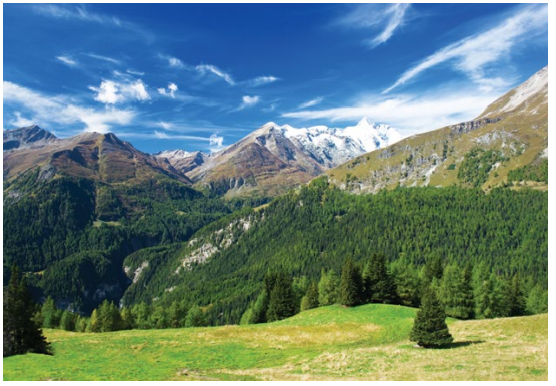
Mountains and climate
Mountains play an important role in shaping the climate. They create a barrier to air masses, which cannot easily pass the high peaks. For this reason, different slopes of the same mountains often have different climate conditions, with more precipitation on one side than on the other. Average temperature and landscapes may also differ significantly
Mountains are also distinctive in that they bring together a large number of different climates in a small area: the climate and landscapes change at different levels from the bottom to the top of the mountain. (Fig. 2.7.1). They are therefore called ‘altitudinal zones’ (‘altitude’ means ‘height’).
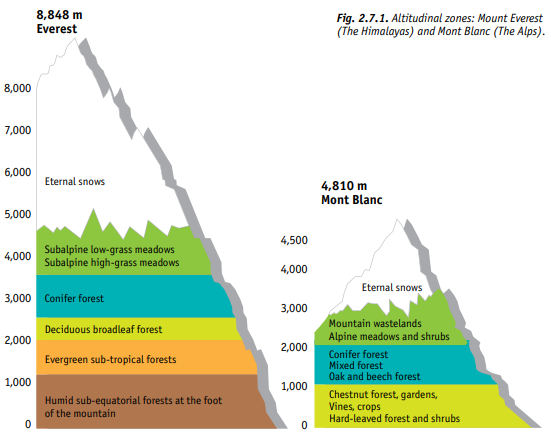
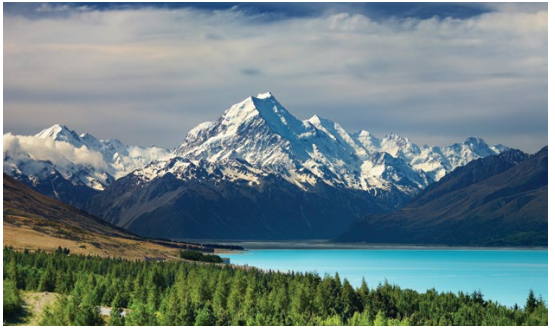
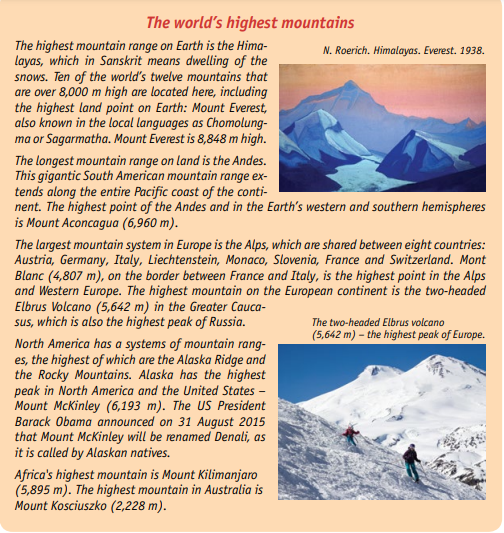
You’ve probably wondered why mountain peaks are often covered with snow, even in tropical latitudes. The first mountain climbers quickly found that the higher they went, the lower the temperature became and the harder it became to breathe. Air is heated by the sun and by the earth’s surface. Once it has become warm, it rises and expands, losing its heat. So, with increasing altitude, the air pressure and its temperature gradually decreases.
With elevation, temperature falls on average by 6 °C per kilometre from the earth’s surface. So, if the temperature at the foot of a 4000 m mountain is +24 °C, the temperature at the top will be around 0 °C. That is why, even through the average air temperature in the tropics never drops below zero, there can still be snow at high altitude on mountains.
Mountains affect the climate, but they are also highly dependent on it. Mountain regions are among the first to respond to changes in climate conditions. The main ‘indicator’ of climate change in the mountains is glaciers, which shrink or grow depending on whether the climate is becoming warmer or colder.
Melting beauty
Glaciers are formed in mountain ranges when the build-up of snow in the upper parts of the mountains turns to ice. The formation of a glacier requires a cold and wet climate, in which more snow falls during the year than has time to melt. As soon as temperatures rise and precipitation declines, the glacier ceases to grow and starts to melt.
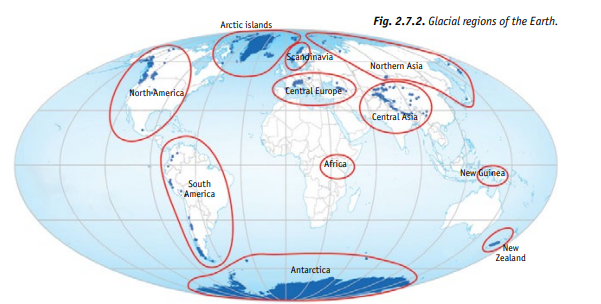
Mountain glaciers around the world began to melt (to ‘retreat’) about 15,000 years ago, when the last period of glaciation gave way to a new period of warmer climate. This melting process was accompanied by short periods when glaciers advanced once again. We know from history that in the 5th–7th centuries A.D. many mountain passes that are now occupied by glaciers were used as caravan routes. Then the climate became colder, glaciers began to grow, and by the 17th–18th centuries these passes were not longer open. One example is the famous St. Gotthard Pass in the Alps. When the poet Frederick Schiller described it in 1799: ‘To the solemn abyss leads the terrible path, The life and death winding dizzy between’, crossing the snow-covered pass was wildly dangerous and possible only during a couple of summer months.
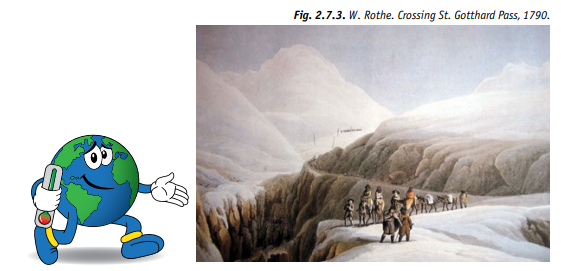
However, over the past 40 years, glaciers around the world have been retreating particularly fast (Fig. 2.7.4). Scientists are sounding the alarm: the rapid melting of mountain glaciers, which we are seeing today, does not coincide with a natural cycle. Reduction in volumes of mountain ice may lead to catastrophic consequences for the environment and the economy of mountain regions, as well as of plains around mountains, which are home to as many as one in six of the world’s population.


Glaciers in the Himalayas are retreating by an average of 10–15 m per year. The Gangotri glacier, which is the source of the River Ganges, is melting particularly fast, retreating by 30 m each year. Gangotri is one of the main sources of water for the 500 million people who live along the Ganges River.
Glaciers in Peru are also retreating very fast. According to the most conservative estimates, their area has been reduced by a third over the past 30 years.
The African volcano, Kilimanjaro, has suffered perhaps the worst of all: its famous ice cap, which was immortalized in Ernest Hemingway’s novel ‘The Snows of Kilimanjaro’ has almost entirely disappeared

In the mid-19th century the Glacier national park in the Rocky Mountains, on the border between the United States and Canada, was home to as many as 150 glaciers. By the start of the 21st century only 25 remained and scientists predict that glaciers will completely disappear from the park in coming decades, so visitors who want to see what the park was originally famous for should hurry up!
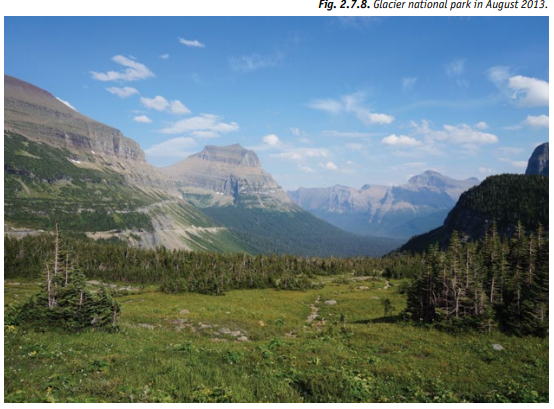
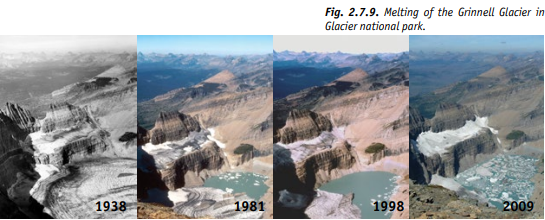
The Argentiere and Mont Blanc glaciers, like many other glaciers in the Alps, began to decline sharply after 1870, since when they have retreated by more than 1 km. The European Environment Agency expects that 75% of Alpine glaciers will have melted by 2050. The volume of glaciers in New Zealand decreased by 11% from 1975 to 2005. The most rapidly melting glaciers in that island country are the Tasman, Classen, Mueller and Maud glaciers.
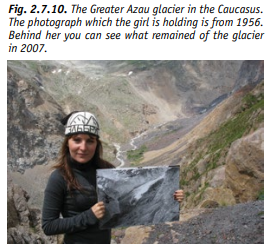
The Azau glacier in the Caucasus has undergone significant changes. At the end of the 19th century the melting process caused it to divide into two parts, called the Lesser and Greater Azau. Today the Greater Azau is no
longer great. From 1957 to 1976 the glacier retreated by 360 m, and then by a further 260 m in the period from 1980 to 1992. The Lesser Azau is retreating by about 16 m each year. The number of glaciers in the Altai Mountains in Eastern Russia decreased by 7.5% from 1952 to 1998, and those which remain have retreated by 100– 120 m compared with their position in the mid-19th century. The Sofia glacier, which is under observation by experts from Altai State University, has retreated by 1.5–2 km in the last 150 years. This glacier is also ‘rising’ at a rate of 20–30 m each year.
How climate change affects people who live in the mountains
Living in the mountains is not easy. High altitude, difficult terrain and frequently changing weather make it much harder to grow foods and manage cattle here than on the plains.
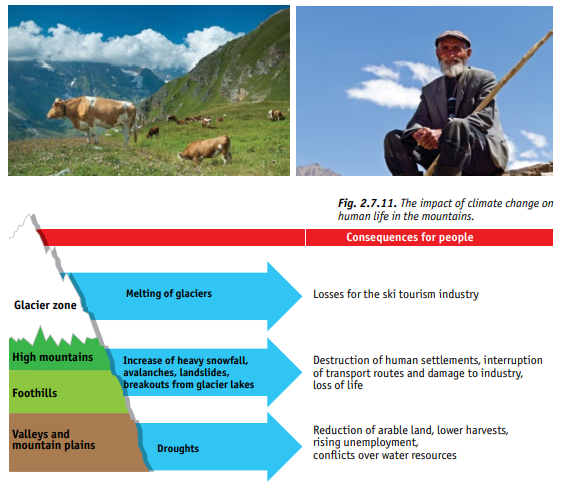
Since ancient times, people have settled in narrow mountain valleys, separated from each other by high mountain ranges with steep slopes, which often made contacts between the neighbouring valleys (and populations) very difficult. Even now, people living in mountainous regions often have their own unique customs, culture and ways of making a living. The way of life of mountain people and their principal livelihoods – agriculture and tourism – are directly dependent on the climate. Even small changes in climate can negatively affect the well-being of people in mountain regions.
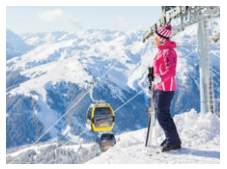
Tourism going downhill
The example of the Alps shows how climate change is affecting the tourist trade in mountain areas. At present ski tourism provides up to 20% of the income of Alpine countries. For the 13 million people living in the Alps in Austria, Germany, Switzerland and France, lack of snow is an economic catastrophe: two thirds of all tourists who come here do so in order to enjoy skiing and snowboarding.
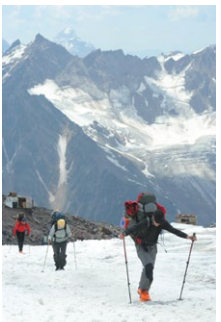
Forecasts give serious cause for concern: by 2030 there will be almost no snowfall in the Alps below 1,000 m altitude, which will force many popular ski resorts out of business. Half of all the ski resorts in Austria are at altitudes up to 1,300 m and will be forced to close due to lack of snow. The pessimistic predictions are already starting to come true: in the winter of 2006–2007, as many as 60 of the total 660 alpine ski resorts remained closed and many others could only operate by using artificial snow, which greatly increased their already high costs. The result has been a fall in demand for holidays in the Alps.
How can mountain regions cope without snow? The sport and leisure industry is adapting as best it can, working to develop other types of tourism and recreation, which are less dependent on snow. Areas that were used for skiing are being converted into leisure parks and all-year-round health resorts. A time may come when people will come to the Alps, not for winter sports, but to enjoy walks along
mountain lakes, savour the local food and breathe the fresh mountain air.
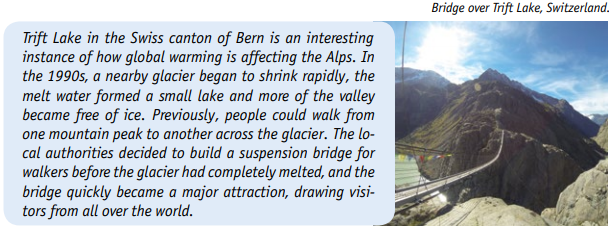
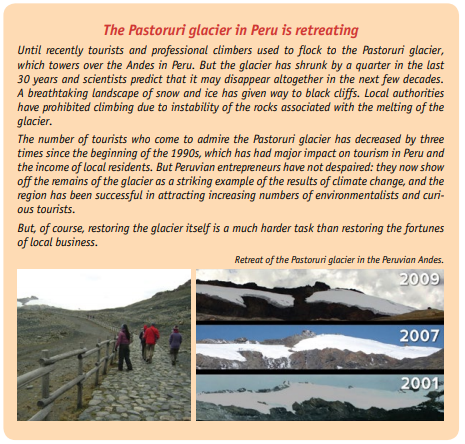
Natural disasters in the mountains
Decline of the tourist business is not the most deadly threat to mountain people from global warming. They also have to fear natural disasters – avalanches, landslides and floods – which have become ever more frequent in the mountains as the climate changes and which pose a threat to human life as well as causing huge damage to the local economy.
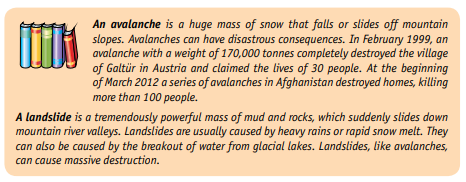
When a glacier retreats it produces melt water, which accumulates in a mountain valley to form a glacial lake. As the quantity of water increases, the lake may overflow and break its banks, causing a flood. Scientists believe that 20 glacial lakes in Nepal and 24 in Bhutan pose a serious threat to people living further down the valley. If these lakes break their banks, and the water gushes into the valley, many people are in danger of losing their lives or at least their homes.
Several such floods have already occurred in recent years in the valleys of the Thimphu, Paro and Punakha-Vangdu rivers in Bhutan. Danger to the local population can be reduced by digging protective channels and dams before
such flooding occurs.
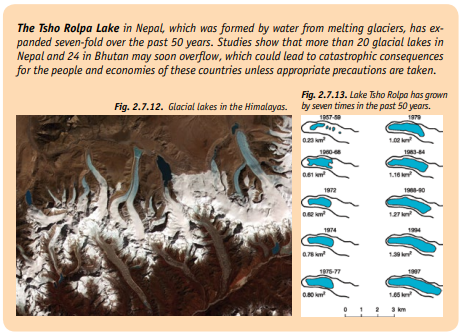

Reduction of fresh water stocks
The future reduction of fresh water stocks, both in mountain regions and in plains adjacent to mountains, presents a serious threat. Glaciers are one of the main sources of fresh water on Earth, since they are the source of many rivers. Reduction in volumes of ice will lead to water shortages in the regions around mountains, making conditions much worse for agriculture, mining and electric power generation. Shortage of fresh water in areas near mountains is already leading to serious political conflicts in some parts of the world.
Mountains have always been associated with danger and climate change on Earth may add to the risks. Rise of temperatures, change in amounts of precipitation, the melting of mountain glaciers and more frequent occurrence of unpredictable natural disasters could lead to catastrophic consequences for the environment, people and economy of mountain regions and of the regions around mountain ranges.
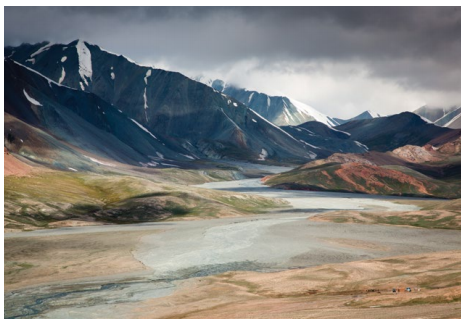
Questions
1. How high has a mountain climber climbed if he is at a level
where the temperature is -9 °C, while the temperature at the foot
of the mountain is +18 °C?
2. Will snow remain at the top of a mountain, which is 5200 m
high, if the air temperature at its foot is +30 °C on the hottest
day of summer?
3. Why are mountain glaciers often called indicators of climate
change?
What happens to them when the air temperature changes?
4. Why is there often a great deal of ethnic diversity in mountain
regions?
5. What are the main livelihoods of people living in mountain
regions. How they are affected by climate change?
Task
Task 1. Mark the highest peaks on each continent on a contour map of the world. Which mountain systems are they a part of? In which countries are they located?
Task 2. The beauty and the inaccessibility of mountains have always made them a source of inspiration for the greatest poets, writers, artists and composers. Name some famous works of literature or art, which show various mountain ranges or peaks. Choose any work that you particularly like and explain what the author would have to change if or he or she had lived in an era of global climate change. How could he or she do it.
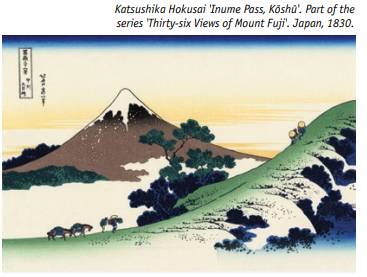
Task 3. Game
The players divide into two teams.
Team №1 live in High Village, which is located in the Rapid River mountain valley. In recent years the melting of glaciers in the high mountains has caused the Rapid River to flood its banks on several occasions, causing problems for local residents. So the local people want to build a dam on the river to protect themselves from floods and at the same time to produce electricity and create new jobs. The mountain people are not rich, they have no money for the construction of the dam and live mainly from what they can grow and the animals they keep. In recent years, due to rising temperatures the people of High Village have begun to grow flowers and exotic fruits.
Team №2 live in the village of Cowgrazing, which is on the plain near the mountains, downstream on the Rapid River. The village is prosperous, its people are farmers and use water from the river for irrigation and for drinking. The people of Cowgrazing like exotic food, entertainment and travel. The local budget of Cowgrazing has plenty of money to finance new construction projects.
Members of the teams need to discuss the following questions (the teacher or one of the students can play the role of Minister for Regional Development, who will manage the negotiations):
1) What will be the consequences for the village of Cowgrazing, if the people of High Village build a dam without consulting them?
2) On what terms can the village of Cowgrazing agree to the dam and provide money for its construction?
3) Can the people of High Village find ways to protect themselves from the consequences of climate change without
building a dam?
4) What new projects and types of business can the people of High Village and Cowgrazing work on together?
